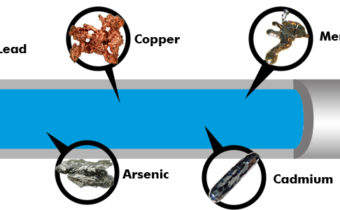Organic matter in water
Organic matter in water
The laboratory-scale ultrafiltration (UF) experiments were conducted to determine the effect of the presence of powdered activated carbon (PAC) on the UF process performance, in terms of flux decline and the possibilities of membranes cleaning during backwashing. Poly(vinylidene fluoride) membranes formed by the phase inversion technique were used in the UF experiments. A model solution was prepared as a mixture of humic acids (HA) and phenol in concentration of 10 and 1 mg l−1, respectively. Commercial powdered activated carbons CWZ 11 and CWZ 30 (Gryfskand Sp. z o. o., Hajnówka, Poland) were used as the adsorbents. PAC dosage was in the range of 10–100 mg PAC l−1. The process was carried out in the cross-flow system. It was found that PAC addition to the distilled water leads to a small drop in the permeate flux, regardless of PAC dose and its type. Although PAC particles are too large to block the membrane pores inside, they deposit on the membrane surface and partially can plug the surface pores. The experimental results demonstrate that the backwashing process applied in combined PAC/UF system was especially effective when PAC dosages were <20 mg PAC l−1. However, a similar permeate flux was maintained for all carbon dosages used and reached the value of about 1 m3 m−2 d−1. Moreover, no further drop in the permeate flux for PAC addition to the solution containing foulants (HA) was observed. Effectiveness of the removal of HA and phenol from the model solutions was also investigated. In the PAC/UF system HA were removed in about 90%, whereas the complete removal of phenol was achieved for PAC dosage equal to 100 mg l−1.
the water-stability of aggregates in many soils is shown to depend on organic materials. The organic binding agents have been classified into (a) transient, mainly polysaccharides, (b), temporary, roots and fungal hyphae, and (c) persistent, resistant aromatic components associated with polyvalent metal cations, and strongly sorbed polymers. The effectiveness of various binding agents at different stages in the structural organization of aggregates is described and forms the basis of a model which illustrates the architecture of an aggregate. Roots and hyphae stabilize macro-aggregates, defined as > 250 μm diameter; consequently, macroaggregation is controlled by soil management (i.e. crop rotations), as management influences the growth of plant roots, and the oxidation of organic carbon. The water-stability of micro-aggregates depends on the persistent organic binding agents and appears to be a characteristic of the soil, independent of management.
What’s in the Water
Natural Substances
Natural Organic Matter (NOM)
Inorganic Substances (Iron, Manganese, sodium, chloride)
Anthropogenic Substances
Pesticides
Organic Solvents & Other Industrial Compounds
Carcinogens
Pharmaceuticals
Endocrine Disrupting Compounds
Flame Retardants
Pathogens and other microorganisms
NOM in Natural Waters:
Some definitions
4
Groupings Based on Origin
autochthonous compounds are created within the water
body
allochthonous compounds can originate from either the
soil or from upstream water bodies
aquagenic, substances originating from any water body
pedogenic for substances originating from soil










